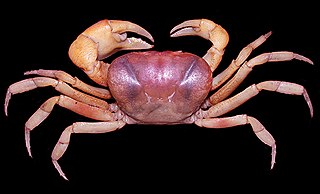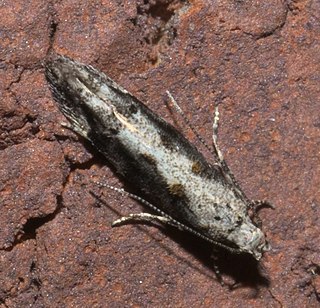
Parathelphusinae is a subfamily of freshwater crabs, which was formerly placed in the family Parathelphusidae; they are mainly found in South and Southeast Asia, but also found elsewhere in Asia and in Australia. The family is now considered as a junior synonym of the family Gecarcinucidae.
Oziotelphusa dakuna is a species of crab in the family Gecarcinucidae.

Oziotelphusa is a genus of freshwater crabs in the family Gecarcinucidae. Its members are found in Sri Lanka and southern India. The genus was formerly placed within family Parathelphusidae, but now it is accepted that Parathelphusidae is the junior synonym of Gecarcinucidae.

Oziotelphusa hippocastanum is a species of crustacean in the family Parathelphusidae. It is endemic to Sri Lanka. Its natural habitats are subtropical or tropical moist lowland forests, subtropical or tropical swamps, and rivers. It is threatened by habitat loss.
Oziotelphusa intuta is a species of crab in the family Gecarcinucidae.
Oziotelphusa kodagoda is a species of crab in the family Gecarcinucidae.
Oziotelphusa populosa is a species of crab in the family Gecarcinucidae.

Coleotechnites is a genus of moths in the family Gelechiidae described by Vactor Tousey Chambers in 1880. One of the best known species is the lodgepole needle miner, a serious pest of forest trees in North America.
Riculoides is a genus of moths belonging to the subfamily Olethreutinae of the family Tortricidae.
Peptoniphilus is a genus of bacteria in the phylum Bacillota (Bacteria).
Coleotechnites gallicola is a moth of the family Gelechiidae. It is found in North America, where it has been recorded from Colorado and California.
Scrobipalpa gallicola is a moth in the family Gelechiidae. It was described by Mark I. Falkovitsh and Oleksiy V. Bidzilya in 2003. It is found in Uzbekistan.
Oziotelphusa ceylonensis is a species of freshwater crabs in the family Parathelphusidae. It is endemic to Sri Lanka. The species is not threatened in their habitats, where they observed to be survive well in man-made settlements as well. The species was discovered from nine localities around Kandy hills. The preferred habitats are embankments of paddy fields, where many irrigation canals constructed to provide continuous supply of water to the field.
Oziotelphusa ritigala is a species of freshwater crabs in the family Gecarcinucidae. It is endemic to Sri Lanka. The species is categorized as vulnerable by IUCN Red List due to less abundance is observed localities and much restricted ecology.
Oziotelphusa stricta is a species of freshwater crabs in the family Gecarcinucidae. It is endemic to Sri Lanka. The species was initially categorized as Near Threatened by the finders, but recent observations included to vulnerable by IUCN Red List due to less abundance is observed localities and much restricted ecology.
Traversoa is a genus of fungi in the Botryosphaeriaceae family.
Anaerococcus hydrogenalis is a bacterium from the family Peptoniphilaceae. It is present in vaginal discharges and ovarian abscesses. Presence of Anaerococcus hydrogenalis in the gut metabolism and their coline consumption has been associated to cardiovascular diseases. Contrary to most of the species in this genus, Anaerococcus hydrogenalis is indole-positive. Also, some strains in this specie can produce urease.
Anaerococcus tetradius is a bacterium from the family Peptoniphilaceae. It was first isolated from vaginal discharges and ovarian abscesses, but is a common member of the vaginal flora.



